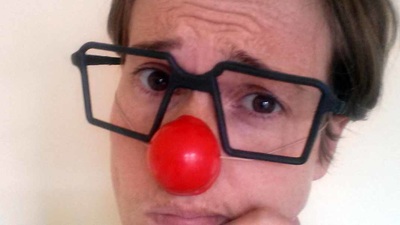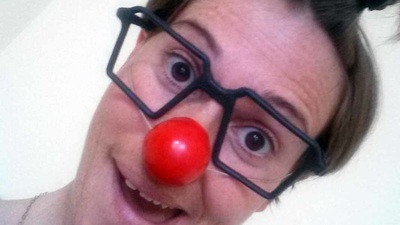|
I reckon the first step in Healthcare Clowns becoming more integrated in our hospitals is as simple as using the right language. One slip of the tongue during referrals and we are banished into the realm of wishy-washy- do-gooder-nuisance forever more. How do we communicate what we do in a meaningful way to professionals who have had years of serious, intensive training in evidence-based medicine? How do we communicate how serious we are about what we do, without undermining their much more serious task as front-line healthcare practitioners?
In a normal day on the wards (which might include various of the following: Paediatric Intensive Care, Cardiology, Haemato-Oncology, Neurosurgery, Neurology, Complex Respiratory, Long Term Ventilation, ENT, Endocrine, Eating Disorders, General Surgery, Maxillo Facial, Plastics, Opthamology, Gastroenterology, Renal, Dialysis, Urology, Orthopaedics, Diabetes, Medical Paediatrics, Rheumatology) we will come across Consultants, Nurses, Pharmacists, Administrators, Clerical Staff, Domestic Staff and Allied Health Professionals. And that's a whole load of medical language already. I'm not saying I want to be full of jargon. Ideally, I just don't want to sound like an idiot. So here is a tiny list of phrases/words that I have picked up on my way and can remember off the top of my head (with help from google). I am sure you are familiar with all of this and I am sure that you know more, so please share with me! First, it's good to be able to describe the work itself in a concrete way. Benefits of a visit from a healthcare clown can include a reduction in stress, anxiety and fear, mobilisation of respiratory secretions, increased Oxygen in the blood, lower blood pressure, muscle relaxation, activation of the immune system amongst others. (Is Laughter the best Medicine?, 2016). Sounds better than, 'it might make them feel better'. Patient centred approach Evidence-based approach Integrative Medicine Complimentary instead of alternative Physical and Psychological wellbeing Strict Isolation is used for diseases spread through the air and in some cases by contact. Patients must be placed in isolation to prevent the spread of infectious diseases Contact isolation is used to prevent the spread of diseases that can be spread through contact with open wounds. Health care workers making contact with a patient on contact isolation are required to wear gloves and an apron. Respiratory isolation is used for diseases that are spread through particles that are exhaled. Those having contact with or exposure to such a patient are required to wear a mask. Barrier nursing is a set of stringent infection control techniques used in nursing. The aim of barrier nursing is to protect medical staff against infection by patients, particularly those with highly infectious diseases. Reverse barrier nursing is similar, but concentrates on the reverse: protecting vulnerable patients, such as those with weakened immune systems, against infection by medical staff. The body systems – musculoskeletal, cardiovascular and blood systems, respiratory, digestive, lymphatic, endocrine, urinary, reproductive, sensory and nervous systems And some up to date language that might apply to clients that we visit: Behaviours that challenge instead of 'challenging behaviour' Living with/has instead of 'suffers from' Partially sighted instead of visually impaired Down Syndrome instead of Down's Syndrome PMLD (Profound and Multiple Learning Disabilities) or LD (Learning disabilities) instead of Special Needs Wheelchair user instead of wheelchair bound Non-disabled instead of able-bodied And off we go down the corridor, winning over one healthcare practitioner at a time...*walks into door*
0 Comments
Leave a Reply. |
AuthorI am a therapeutic clown and performer. Writing here is part of my wider practice and maybe some of my thoughts will trigger some thoughts of your own and I hope that helps. Archives
May 2024
Categories |



 RSS Feed
RSS Feed